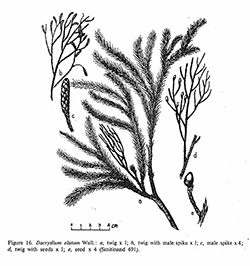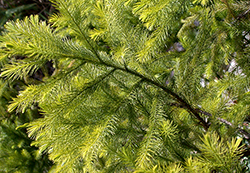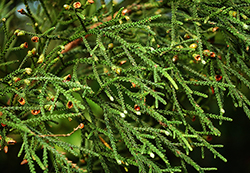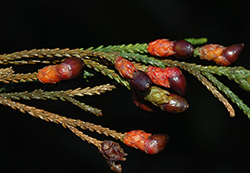e-Flora of Thailand
Volume 2 > Part 3 > Year 1975 > Page 197 > Podocarpaceae > Dacrydium
Dacrydium elatum (Roxb.) Wall. ex Hook.
Lond. J. Bot. 2: 144 t 2. 1843; Kurz, Fl. Burm 2: 499. 1877; Hook.f., Fl. Br. Ind. 5: 648. 1888; Dallim. & Jacks., Handb. Conif.: 48. 1923; Ridl., Fl. Malay Penins. 5: 279. f. 227. 1925; Suvatabandhu, J. natn. Res. Coun. Thailand 2: 61. 1961; Larsen, Dansk Bot. Ark. 20: 123. 1962; de Laub., J. Arnold Arbor. 50: 285. 1969.— Juniperus elata Roxb., Fl. Ind. ed. 2.3: 838. 1832. Fig. 16.
Accepted Name : This is currently accepted.
Description : Tree up to 35 m high 70–120 cm in girth; crown pyramidal with spreading branches and weeping branchlets. Bark greyish brown, scaly, defoliating in irregular patches. Leaves of young plant and sterile branchlets ± 1 cm long, subulate, deeply grooved and shiny; on fertile branchlets ± 0.15 cm long, triangular to narrowly triangular. Seeds ovoid to ovate, 0.5 by 0.3 cm, brown, obliquely seated on the dark red shallowly cup-like and fleshy podophylls.
Thailand : NORTHERN: Phitsanulok; NORTH-EASTERN: Phetchabun, Loei; EASTERN: Nakhon Ratchasima, Chaiyaphum; CENTRAL: Nakhon Nayok; SOUTH-EASTERN: Trat.
Distribution : India, Burma, Cambodia, Malesia (type, Malaya).
Ecology : By streams in lower montane forests on sandstone formation, 1,000–1,300 m alt. Flowering: January–February; fruiting: rather late about August–September.
Vernacular : Samphanpi (สามพันปี), chuang pha (จวงผา)(Northeastern); son hang karok (จนหางกระรอก)(Central); son soi (สนสร้อย), phaya makhampom (พญามะขามป้อม)(Southeastern).
Uses: The wood tends to warping and is not much used in Thailand.




